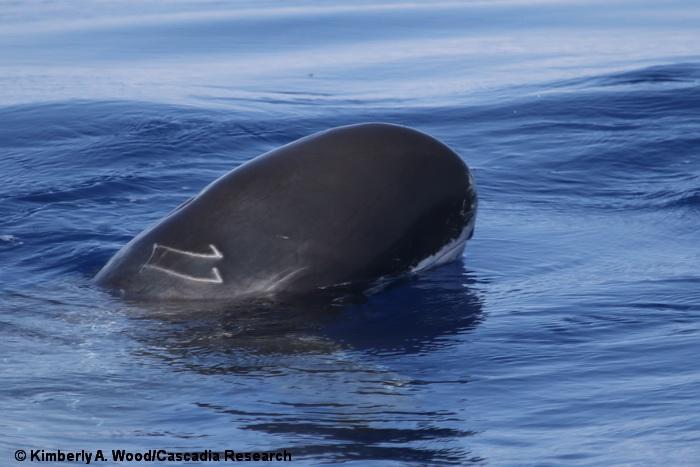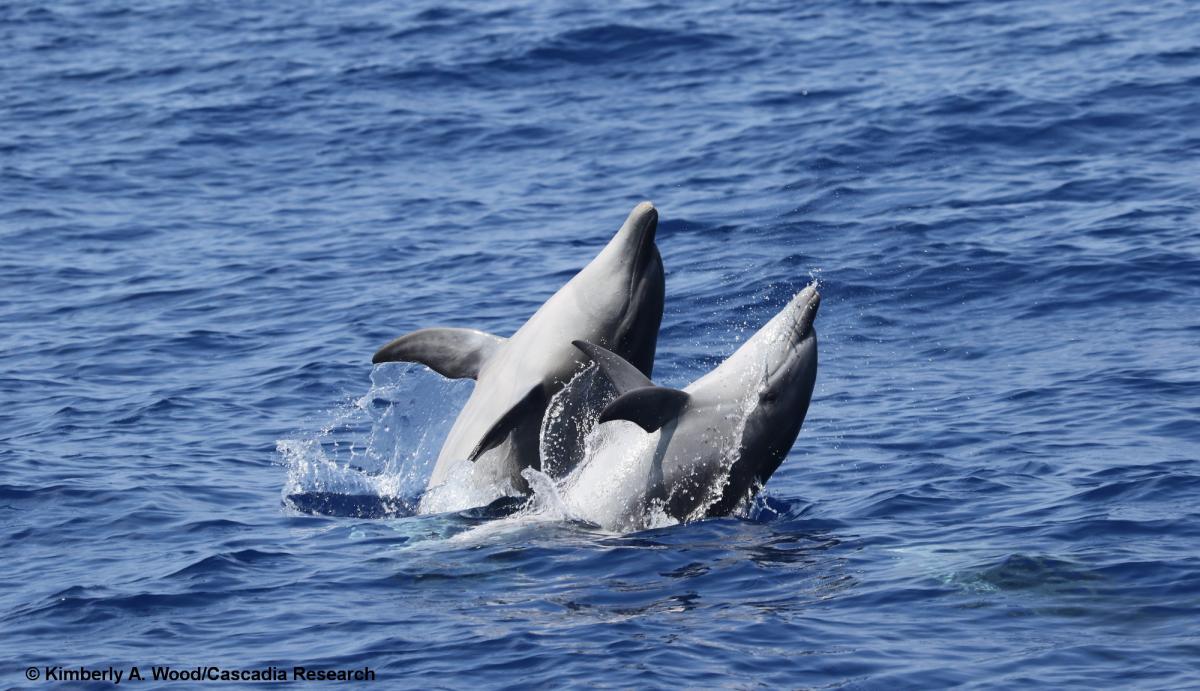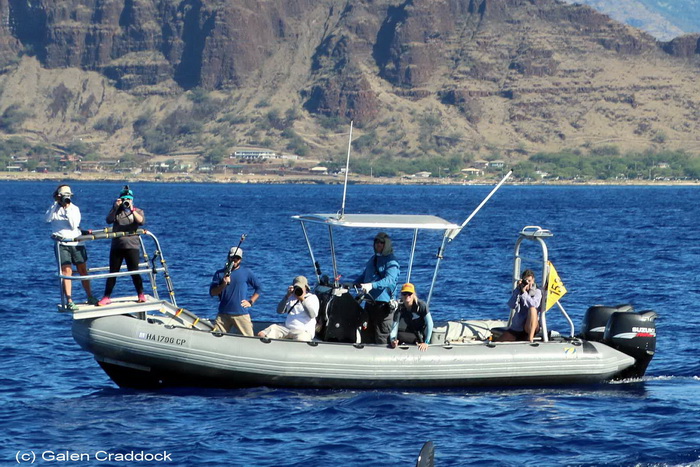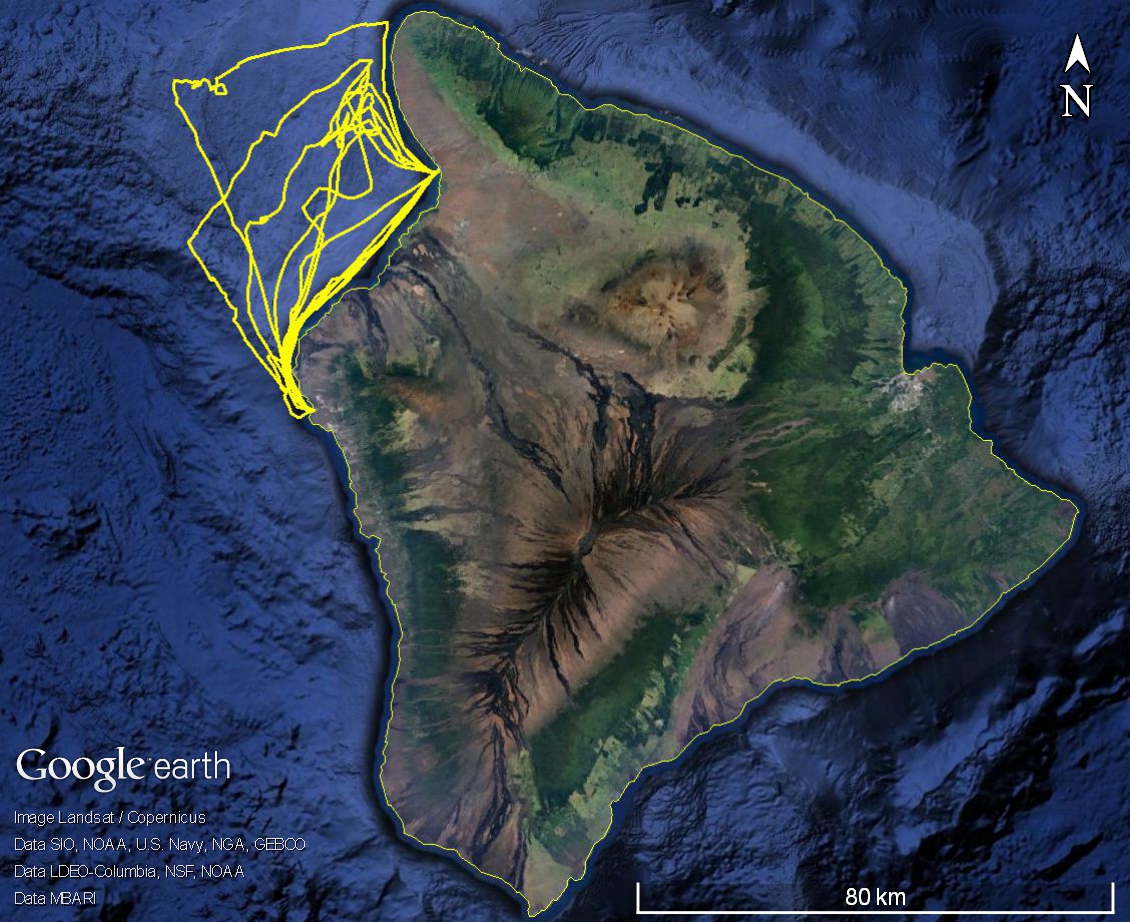We will be undertaking a 14-day field project based out of Kona, Hawai‘i Island starting June 14, 2017. This will be our second field effort in Hawai‘i and our first off Hawai‘i Island this year, and our 16th year of working off the island of Hawai‘i. Although we’ve worked off the island every month of the year, we’ve only had one prior project in the month of June (in 2015). As in most of our field efforts, we are hoping to find and work with false killer whales, and will be working as far offshore as possible with the hopes of encountering individuals from the pelagic population. But like all of our field projects, we will work with all species of whales and dolphins we encounter, photo-identifying individuals (we have photo-ID catalogs of 11 different species in Hawai‘i), collecting remote skin/blubber biopsy samples for genetics, toxicology and hormone chemistry, deploying LIMPET satellite tags to track movements of several different species, and picking up any squid we find to determine what types of prey are in the area.
This project is supported by a grant from the Bycatch Reduction Engineering Program of NOAA Fisheries, with additional support from Dolphin Quest.
The research crew for this project will include Daniel Webster, Kim Wood, Colin Cornforth, Lynn Padilla, Brittany Guenther, and Robin Baird, as well as a number of volunteers.
End of project update

Over the 14 days of field effort we covered 1,857 km off the coast of Kona, had 47 encounters with 11 different species of whales and dolphins, collected 13 eDNA samples (from 7 different species), collected 7 biopsy samples for genetics and a study of the skin microbiome, and took over 38,000 photos for species and individual identification. Overall a good project. The photo above is from June 26th, our second encounter with pygmy killer whales this trip.

The group of pygmy killer whales encountered was the same group seen earlier in the trip, but with better lighting conditions and more cooperative behavior. In this photo you can see the white lips and white that extends onto the face of pygmy killer whales as they age, as well as paired white tooth rakes, commonly seen on the skin of this species.

What pygmy killer whales eat is largely a mystery, as they seem to spend most of their day resting and socializing, and do all of their foraging at night. This photo shows seven individuals logging at the surface, most with just their heads breaking the water’s surface. This type of resting behavior also makes pygmy killer whales very difficult to spot! As well as the IDs of the group, we were able to collect an eDNA sample.
June 25 update

In the last two days we’ve encountered two additional odontocete species for the trip, pygmy killer whales and melon-headed whales, bringing the total to 11 species in 12 days. Today we found a group of about 150 melon-headed whales in just over 500 m water depth west of Kohala. Although we haven’t matched any individuals to our catalog yet, these are probably part of the Kohala resident population of melon-headed whales – this population has the smallest known range of any species of whale or dolphin in Hawai‘i. This population was recently one of the subjects of a new paper out entitled “Nowhere to go: noise impact assessments for marine mammal populations with high site fidelity” – melon-headed whales are one of those species that are susceptible to the impacts of high intensity sounds, and the Kohala residents, with their small range and often with all or almost all individuals in the population together at once, are particularly at risk. We were able to collect two eDNA samples, one biopsy sample, and also deployed a LIMPET satellite tag to track their movements.

There were several infant melon-headed whales in the group – this photo shows both the fetal folds (the vertical creases along the body of a newborn whale or dolphin) and the uncoordinated surfacing behavior typical of a newborn.
June 23 update

The last few days have been quite productive. The highlight was an encounter today with a dwarf sperm whale – we recognized the individual in the field as HIKs020, not only one of the most distinctive dwarf sperm whales that is resident to the island, but the one seen over the longest span off time. HIKs020 was first photographed during our November 2004 field effort, and prior to today’s sighting had been seen in seven different years over a 10-year span – she was last seen in October 2014. Today’s sighting brings her known time of residency off the island to 12 and a half years!

We’ve collected six eDNA samples (from four different species) since June 20th, including one from the dwarf sperm whale, as well as one squid. We collect dead floating squid that we see on the water to help understand the prey that are available for deep-diving odontocetes in the islands, and send the squid to William Walker of the Marine Mammal Lab in Seattle for identification.


We’ve also seen two more pelagic species in the last few days. On both June 21st and 22nd we had groups of striped dolphins in deep offshore waters. Striped dolphins around the Hawaiian Islands tend to avoid boats, so we stayed with the group just long enough to get a couple of good photos, and then collected an eDNA sample from the fluke print of one individual.

The other pelagic species we’ve encountered in the last few days was a sperm whale. Although we only saw a lone individual, it is possible others were in the area but were just down on a long dive. We were able to get a fluke photograph of the individual, which we will send to the Southwest Fisheries Science Center for comparison to their photo-identification catalog.
June 18th update

In the last four days we’ve surveyed off north Kona, south Kona, and offshore of Kona as far as 30 kilometers, with sightings of four different species of odontocetes. By far the most unusual sighting was a group of about 20 Risso’s dolphins, seen in 2,200 m depth offshore of Honaunau on June 18th. This was only our 11th sighting of this species in Hawaiʻi since we first started working here in 2000 – our last sighting was in April 2015. They are typically an offshore species, and are usually somewhat wary of boats, so are not easy to get close to for tagging or genetic sampling. This trip we’ve started collecting eDNA samples – water samples from the fluke prints of different species – in collaboration with the Cetacean Conservation and Genomics Laboratory of Oregon State University, and we collected one sample from the Risso’s dolphin group.

Risso’s dolphins acquire scars on the body as they age, which can be used to identify individuals. We’ve been collecting photos of Risso’s in all our previous encounters in order to set up a photo-ID catalog of this species in Hawaiʻi and were able to obtain good ID photos of more than 10 individuals from this encounter. Photo © Colin J. Cornforth.

Two juvenile Risso’s dolphins with a diverse array of body scars! Photo © Kimberly A. Wood
We’ve also had sightings of several more groups of short-finned pilot whales, as well as spinner dolphins, pantropical spotted dolphins, and bottlenose dolphins.

A pantropical spotted dolphin off north Kona June 16, 2017. Photo © Kimberly A. Wood

A Hawksbill Turtle seen off north Kona June 16, 2017. Photo © Colin J. Cornforth

On June 15th we encountered a group of about 10 bottlenose dolphins just south of Kailua-Kona. We were able to photo-identify the individuals present, and also deployed a LIMPET satellite tag on one individual, to track its movements. There are four island-associated populations of bottlenose dolphins recognized in Hawai‘i, based on photo-ID and genetics, but some of our tagging work in recent years is documenting some overlap among the stocks, so we are trying to get a better idea of the movements of individuals over periods of several weeks. The individual we tagged is one from our catalog, an adult male first documented off Hawai‘i Island in 2006.
June 14 update

Our first day off Kona involved dodging rain showers and minor engine problems, but we were able to encounter three groups of short-finned pilot whales during the morning, and obtained identification photos of about 40 different individuals among the three groups. These groups are likely part of the eastern main Hawaiian Islands resident community of short-finned pilot whales.


We were happy to see one newborn calf in one of the groups, identifiable as a newborn by the faint vertical lines on the side (“fetal folds”) as well as the lighter gray coloration. Short-finned pilot whales are our most frequently encountered species of odontocete in our work off Hawai‘i Island, representing about a quarter of all sightings, so we expect to see them many more times over the next two weeks.

The research vessel we’ll be using for this project, a 24’ Hurricane. Photo by Galen Craddock.

Our survey effort off Hawai‘i Island over the last 15 years.

Our survey effort off Hawai‘i Island during our only prior June field effort.